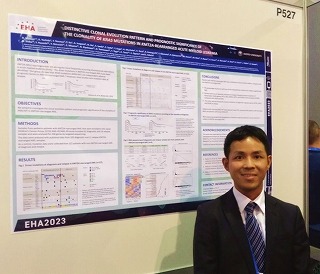28th EHA Congress Travel Award 受賞レポート 松尾 英将
.jpg)
名前:松尾 英将【京都大学大学院医学研究科 人間健康科学系専攻】
発表形式:Poster
Title:
Distinctive clonal evolution pattern and prognostic significance of the clonality of KRAS mutations in KMT2A-rearranged acute myeloid leukemia
Authors:
Hidemasa Matsuo 1, 2, Kenichi Yoshida 3, Yasuhito Nannya 3, 4, Yuri Ito 1, Aina Inagami 1, Nana Ito 1, Shinju Iyoda 1, Shoji Saito 5, Yuhki Koga 6, Hiroshi Moritake 7, Kiminori Terui 8, Koji Kawaguchi 9, Yasuhiro Okamoto 10, Hideki Nakayama 11, Miyako Kanno 12, Moeko Hino 13, Yusuke Akane 14, Akiko Inoue 15, Akira Shimada 16, Hiroaki Goto 17, Hiroo Ueno 18, Junko Takita 18, Genki Yamato 19, Norio Shiba 20, Yasuhide Hayashi 21, Yuichi Shiraishi 22, Satoru Miyano 22, 23, Nobutaka Kiyokawa 24, Daisuke Tomizawa 25, Takashi Taga 26, Akio Tawa 27, Seishi Ogawa 3, and Souichi Adachi 1
Affiliations:
1. Human Health Sciences, Graduate School of Medicine, Kyoto University, Kyoto, Japan
2. Clinical Research Center, National Hospital Organization Nagoya Medical Center, Nagoya, Japan
3. Department of Pathology and Tumor Biology, Graduate School of Medicine, Kyoto University, Kyoto, Japan
4. Division of Hematopoietic Disease Control, Institute of Medical Science, The University of Tokyo, Tokyo, Japan
5. Department of Pediatrics, Shinshu University School of Medicine, Matsumoto, Japan
6. Department of Pediatrics, Kyushu University, Fukuoka, Japan
7. Division of Pediatrics, Faculty of Medicine, University of Miyazaki, Miyazaki, Japan
8. Department of Pediatrics, Hirosaki University Graduate School of Medicine, Hirosaki, Japan
9. Department of Hematology and Oncology, Shizuoka Children’s Hospital, Shizuoka, Japan
10. Department of Pediatrics, Kagoshima University Graduate School of Medical and Dental Sciences, Kagoshima, Japan
11. Division of Pediatrics, Kyushu Cancer Center, Fukuoka, Japan
12. Department of Pediatrics, Yamagata University Faculty of Medicine, Yamagata, Japan
13. Department of Pediatrics, Graduate School of Medicine, Chiba University, Chiba, Japan
14. Department of Pediatrics, Sapporo Medical University School of Medicine, Sapporo, Japan
15. Department of Pediatrics, Osaka Medical and Pharmaceutical University, Takatsuki, Japan
16. Department of Pediatric Hematology and Oncology, Okayama University Hospital, Okayama, Japan
17. Division of Hematology/Oncology, Childhood Cancer Center, Kanagawa Children’s Medical Center, Yokohama, Japan
18. Department of Pediatrics, Graduate School of Medicine, Kyoto University, Kyoto, Japan
19. Department of Hematology/Oncology, Gunma Children’s Medical Center, Shibukawa, Japan
20. Department of Pediatrics, Yokohama City University Hospital, Yokohama, Japan
21. Institute of Physiology and Medicine, Jobu University, Takasaki, Japan
22. Laboratory of DNA Information Analysis, Human Genome Center, Institute of Medical Science, The University of Tokyo, Tokyo, Japan
23. Department of Integrated Analytics, M&D Data Science Center, Tokyo Medical and Dental University, Tokyo, Japan
24. Department of Pediatric Hematology and Oncology Research, National Research Institute for Child Health and Development, Tokyo, Japan
25. Division of Leukemia and Lymphoma, Children’s Cancer Center, National Center for Child Health and Development, Tokyo, Japan
26. Department of Pediatrics, Shiga University of Medical Science, Otsu, Japan
27. Department of Pediatrics, Higashiosaka Aramoto Heiwa Clinic, Higashiosaka, Japan
Abstract:
Background: KMT2A ( MLL) rearrangements are among the most frequently occurring chromosomal aberrations in acute myeloid leukemia (AML). The driver mutations in KMT2A-rearranged AML have been identified. Our group showed that KRAS mutations (KRAS-MT) are independent adverse prognostic factors in KMT2A-rearranged AML (Blood Adv. 2020). However, most studies lack mutation data at relapse.
Aims:We aimed to investigate the clonal evolution pattern and prognostic significance of the clonality of KRAS-MT in KMT2A-rearranged AML.
Methods: Samples from pediatric patients with KMT2A-rearranged AML that were enrolled in the Japan Children’s Cancer Group (JCCG) AML-05/AML-99 study included 62 diagnostic and 16 relapse samples and were analyzed for 338 genes by targeted sequencing. The data were analyzed with published data from 105 diagnostic and 11 relapse KMT2A-rearranged AML samples. As a control, mutation data were collected from 122 patients with non-KMT2A-rearranged AML at diagnosis and relapse.
Results: Twenty-seven patients with KMT2A-rearranged AML and matched data at diagnosis and relapse, showed that mutations in signaling pathway genes (FLT3, KRAS, NRAS, PTPN11, CBL, and BRAF ) were frequently detected in diagnostic samples (25 mutations/27 patients). At relapse, 21 out of 25 signaling pathway mutations (84.0%) and 7 out of 19 other pathway mutations (36.8%) were lost. The loss frequency of signaling pathway mutations was significantly higher than that of other pathway mutations (P=0.002). Mutations of transcription factor genes (WT1, SPI1, GATA2, IKZF1, and RUNX1) were predominantly acquired at relapse; 8 out of 9 mutations (88.9%) were detected at relapse. The percentage of patients with loss of signaling pathway mutations at relapse was 51.9% (14/27 patients), which was significantly higher than that in non-KMT2A-rearranged AML (29.5%, 36/122 patients)(P=0.04). Patients with KMT2A-rearranged AML with loss of signaling mutations at relapse(n=14)frequently acquired mutations of transcription factor genes/cell cycle gene(CCND3), compared with other patients (n=13)(50.0% vs. 7.7%, P=0.03). The other patients frequently acquired mutations of epigenetic regulator genes (SETD2, ASXL1, and BCOR) at relapse (30.8% vs. 0.0%, P=0.04). These patterns were not observed in the non-KMT2A-rearranged AML cohort.
At diagnosis, 10 out of 27 patients (37.0%) harbored KRAS-MT that was lost at relapse in 9 out of 10 (90.0%) patients. Loss of KRAS-MT at relapse indicates that the mutations were in the subclones at diagnosis, and therefore, we examined the prognosis of 167 patients with KMT2A-rearranged AML according to the clonality of KRAS-MT at diagnosis. Patients with subclonal KRAS-MT (n=33) had adverse 5-year event-free-survival rates, compared with patients with wild-type KRAS (n=119)(wild-type vs. subclonal: 50.9% vs. 15.2%, P<0.0001) and patients with clonal KRAS-MT (n=15)(clonal vs. subclonal: 32.0% vs. 15.2%, P=0.22). RNA-sequencing analysis of diagnostic and relapse sample sets from four patients with KMT2A-rearranged AML including two with KRAS-MT loss at relapse was performed. Differentially expressed genes associated with relapse predominantly clustered in pathways related to immune response.
Summary/Conclusion: Patients with KMT2A-rearranged AML have a distinctive clonal evolution pattern, compared with non-KMT2A-rearranged AML. Patients with subclonal KRAS-MT have adverse prognosis and deregulation of immune response pathways may be involved in relapse.
EHA2023参加レポート
この度,JSH Travel Award for EHA Congressに採択していただき,EHA2023 Hybrid Congressで発表して参りましたので,ご報告いたします。これまでに私はASHでの発表経験はありましたが,EHAは初めてでした。過去のJSH Travel Award for EHA Congress受賞者レポートを拝読して,皆様が非常に充実した時間を過ごされていることを知り,ぜひその雰囲気を味わってみたいと考えたことが参加のきっかけとなりました。
EHA2023 Hybrid Congressは2023年6月8~11日にドイツのフランクフルトで対面開催され,また6月14~15日にバーチャルでも開催されました。会場のMesse Frankfurtはフランクフルト中央駅から電車もしくはトラムを使って約10分とアクセスが良く,またEHA参加者には会場周辺の公共交通機関が乗り放題のチケットが配布されており,快適でした。会場内は青と赤のEHAカラーが基調となっており,デザインにも気を遣われている印象でした。私は研究対象であるAMLに関する教育セッションやオーラルセッションを中心に聴講しました。教育セッションではAMLの治療標的や,CAR-T療法を含めた新規治療法開発の現状などが紹介されていました。最新の知識を整理することができた一方で,AMLは他の血液腫瘍と比較して大幅な治癒率向上が期待できるターゲットや薬剤がまだほとんどないことを改めて感じました。創薬研究にも携わる身としては,臨床応用につながる新規薬剤を開発すべく,より一層研究に邁進したいと思いました。

さて,私はKMT2A再構成AMLの初発時・再発時のゲノム異常パターンついて発表しました。初発時AMLにおける遺伝子異常の全体像が明らかにされてきましたが,再発時の遺伝子異常に関する知見は乏しく,またAMLの病型ごとにクローン進化に特徴があるのかは不明です。本研究ではKMT2A再構成AMLの初発時・再発時セット検体のゲノム解析を行いました。その結果,初発時のsignaling変異は再発時に高率に消失し,その消失割合が他の病型よりも有意に高いこと,signaling変異が消失した症例では転写因子等の遺伝子変異を,それ以外の症例ではエピジェネティック制御に関わる遺伝子変異を獲得する頻度が有意に高いことを明らかにしました。以上のクローン進化パターンはKMT2A再構成以外のAML病型では認めないユニークな特徴でした。また私どもがKMT2A再構成AMLの予後不良因子として報告したKRAS変異(Blood Adv. 2020)は再発時にほぼ全例で消失しており,初発時にサブクローナルなKRAS変異を持つ患者は,特に予後不良でした。RNA-seq解析では,再発時検体で免疫応答に関わるパスウェイの活性化が認められました。以上の知見はこれまでの初発時検体のみの解析では困難であった,AMLの病型特異的な再発メカニズムの理解や,新たなリスク分類・治療法の開発につながる可能性があります。今回,世界各国の参加者と直接ディスカッションすることができ,研究を進めていく上で大変貴重な機会となりました。
このような機会を与えて下さいました日本血液学会賞等選考委員会・国際委員会の先生方,日本血液学会事務局の皆様に感謝申し上げます。日頃よりご指導いただいております滋賀県立総合病院 足立壯一総長・病院長,京都大学 小川誠司教授,滝田順子教授,国立がん研究センター研究所 吉田健一分野長,日本小児がん研究グループ(JCCG)の先生方をはじめ,本研究に関わっていただいた全ての皆様に,この場をお借りしまして御礼申し上げます。また本研究にご協力いただきました患者様,ご家族の皆様に感謝いたします。
